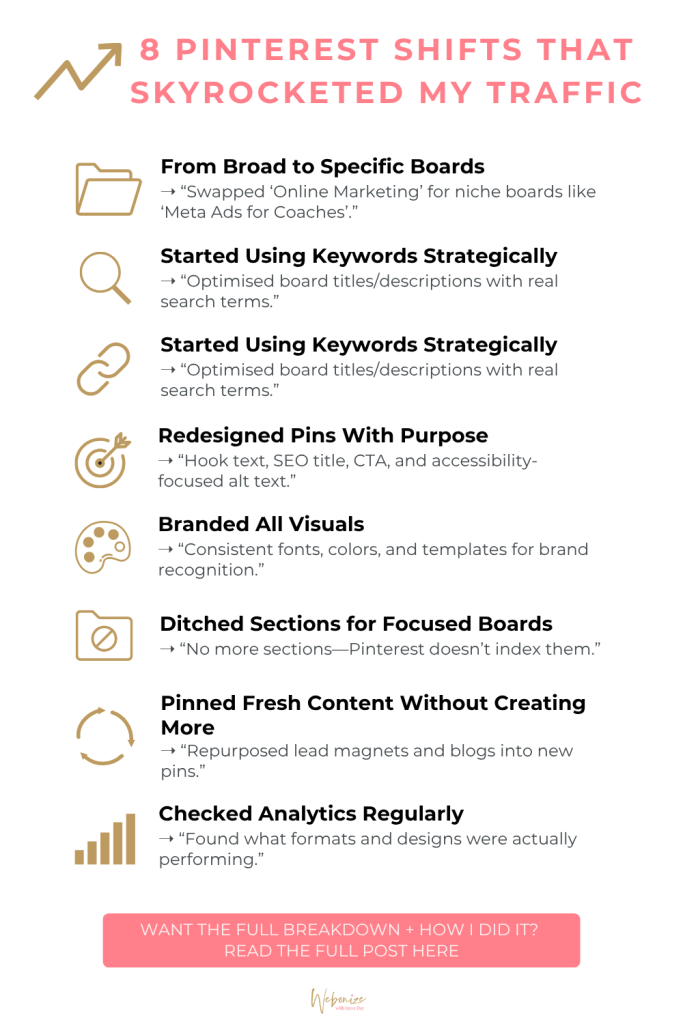If you’re like me, you’ve probably treated Pinterest like a “set and forget” tool at some point.
You create a few boards, pin some blog posts, and hope people find their way to your website. But the truth is, that approach doesn’t cut it anymore (if it ever did).
I’ve been writing consistent weekly blog posts for over a year now. I promote them across different platforms, including Pinterest. But while I’ve been showing up consistently, the traffic coming from Pinterest stayed pretty slow. So slow I started to consider whether it was worth the time it was taking to even create the pins.
But instead, I decided to dig deeper. I wanted to know exactly what was working on Pinterest right now and how I could improve my results without spending hours every week.
Here’s what I discovered and how I’ve already seen a 40% increase in clicks to my website which I know will continue to increase once these strategies continue to compound.
1. I Got Specific with My Board Topics
First, I looked at my existing boards. They were broad. Way too broad.
Things like “Digital Business” or “Online Marketing” sound fine, but they’re not helpful for Pinterest’s algorithm or for real people searching for help.
So I got specific.
Now I have boards like:
- Facebook Ads for Coaches & Course Creators
- Lead Magnet Ideas For Online Business Owners
- Marketing Metrics That Actually Matter
Each one is clear, focused and tied directly to the topics I create content about. This made it easier for visitors to navigate and easier for Pinterest to understand my content.
Tip: Start with 20–30 pins per board. Pinterest themselves have said that you don’t want 100’s of pins in the one board as they won’t perform as well. If you’ve got more content, create new niche boards instead of stuffing one full.
2. I Started Using Keywords Like a Pro
Pinterest isn’t just a visual platform, it’s a search engine.
Every board and pin needs to be optimised, just like a blog post.
That means:
- A keyword-rich title (under 50 characters)
- A natural description using the words your audience actually types into Pinterest
This helped my content show up more often in both search and suggested pins.
3. I Connected Boards to Core Content
For each board, I made sure there was at least one high-quality blog post that matched the topic.
When I create a new board, I don’t let it sit empty. I link it to a blog that reflects the board’s focus like Meta Ads, Funnels or Launch Strategies.
If you’re just getting started, one strong pin per board is plenty. Build from there.
4. I Redesigned My Pins with Purpose
This was a game changer.
Each pin I make now includes:
- Bold, curiosity-driven text on the image
- A short, keyworded title (max 60 characters)
- A strong description with a hook, benefit and a call to action
- Alt text to boost SEO and accessibility
It’s a simple shift but it makes a big impact. You want people to stop scrolling and click through.
5. I Kept It All On-Brand
I use the same colours, fonts, and layouts across all my boards and pins. This builds brand trust and keeps everything looking professional.
If you’ve got a VA or designer, set up a Canva template they can use. It’ll save time and keep things consistent.
6. I Ditched Board Sections
Here’s something I didn’t know until recently – Pinterest doesn’t index board sections for search.
That means breaking a board into sections doesn’t help you get found.
So instead of trying to organise pins within a board, I now create more focused boards from the start.
7. I Started Pinning Fresh Content Without Burning Out
“Fresh content” doesn’t mean you need a new blog post every week.
It means creating new pin designs for your existing content. If you don’t have blog posts it could be podcast episodes or lead magnets. Change the text, layout, or image. Try different angles or hooks.
This tells Pinterest your content is active and relevant.
And the best part? You can reuse your best-performing content without creating something from scratch.
8. I Checked My Analytics Regularly
One of the most helpful things I’ve done is reviewing what’s actually working.
For me, pins with more text and infographic-style designs perform best. That’s not always intuitive, so check your own stats and adjust based on what gets clicks.
Also, some of my top-performing pins weren’t new at all. They were months old.
Unlike other social platforms where posts disappear after a day, Pinterest content lives on. It can keep driving traffic long after it’s pinned. Pinterest is definitely a long-term strategy.
That’s what makes Pinterest such a powerful tool when used well.
Final Thoughts
If Pinterest has been sitting on the back burner in your business, this is your nudge to take a second look.
It doesn’t take hours every week.
What it does take is a smart, focused strategy that aligns with the content you are already creating.
Clean up your boards. Use better keywords. Pin with purpose.
Want to see better results from your content too?
Start by reviewing your own Pinterest boards today. Tweak just one thing based on what you’ve read here and let’s get more eyes on your business.


















I would love to hear your thoughts...